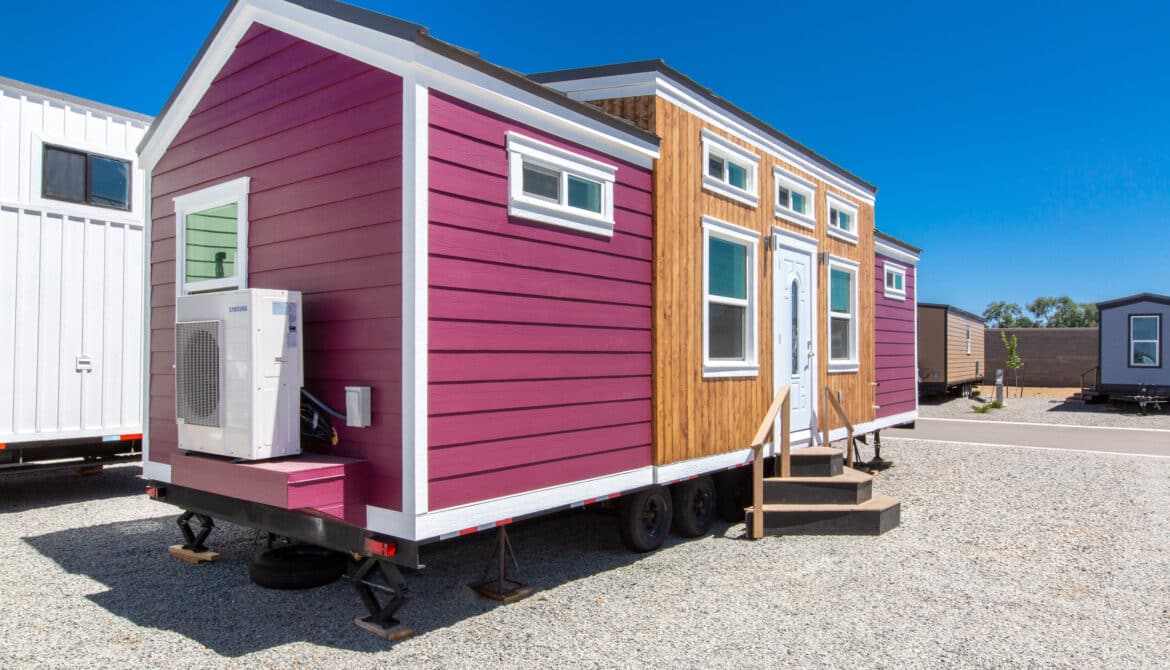Table of Contents
Building a tiny house with Structural Insulated Panels (SIPs) is becoming increasingly popular, as they offer an efficient and cost-effective way to construct a strong and durable home. SIPs are composed of two outer layers of oriented strand board (OSB) connected by an insulating foam core. This combination creates a lightweight panel that is both strong and energy efficient. The panels can be cut to size, eliminating the need for framing and making them ideal for customizing the layout of your tiny house. With the help of a few basic tools, you can assemble the panels quickly and easily. Additionally, since the panels are pre-insulated, there is no need for additional insulation during construction.
The process of building a tiny house with SIPs begins with designing the layout of your home. You will need to decide on things such as wall placement, ceiling height, windows and doors, storage space, living space, etc. Once you have determined your design, you can begin assembling the sips panels according to your plan. To ensure that everything fits together properly, it is important to measure twice and cut once when cutting the panels. After all of the pieces are in place, you can then add any finishing touches such as trim or paint to complete your tiny house build.
Finally, if you are new to building with SIPs or just want some extra guidance during construction, there are plenty of online resources available that provide step-by-step instructions on how to build a tiny house with SIPs. Additionally, many experienced builders have created videos demonstrating their own builds which can be very helpful in understanding the process.
Benefits of Using Structural Insulated Panels
Structural insulated panels (SIPs) are an increasingly popular choice for building tiny houses. SIPs are built using a foam core sandwiched between two layers of oriented strand board (OSB). The combination of these materials makes them strong, energy efficient, and lightweight.
Durability
One of the primary benefits of using SIPs is their durability. They provide superior protection from the elements and can withstand extreme temperatures without warping or cracking. Additionally, they are resistant to mold, mildew, and rot. This makes them ideal for building tiny houses in areas with harsh weather conditions.
Energy Efficiency
Another benefit of using SIPs is their energy efficiency. The foam core helps to insulate the house from both heat and cold air, resulting in lower energy bills. Additionally, the tight seal created by the OSB layers prevents air leakage and helps to further reduce heating and cooling costs.
Lightweight
Finally, SIPs are much lighter than traditional building materials such as wood or brick. This makes them easier to transport and assemble on site, saving time and money during construction. Additionally, they require less labor to install than other materials, making them a cost-effective option for those looking to build a tiny house on a budget.
Designing the Lightship Tiny House
When designing a tiny house with structural insulated panels (SIPs), it is important to consider the layout of the home. Every inch of space must be maximized in order to make the most efficient use of the home’s interior. The lightship tiny house is an example of how a small space can be designed to maximize comfort and efficiency.
Main Doorway
The main doorway of the Lightship Tiny House is located at the center of one side of the house. This allows for easy access and also creates a sense of balance within the design. The door has been designed to be wide enough to accommodate standard furniture pieces, such as a sofa or loveseat, while still being narrow enough to fit comfortably in the limited space available.
Storage
The Lightship Tiny House makes use of several storage solutions throughout its design. In addition to traditional cabinets and drawers, there are built-in shelves and cubbies that provide additional storage space without taking up too much room. Additionally, several closets have been included that allow for ample clothing storage without compromising on floor space.
Living Space
The living area in the Lightship Tiny House is spacious yet cozy, thanks to cleverly placed windows that let in plenty of natural light. The living area includes a comfortable seating area and a dining table with chairs that can easily be tucked away when not in use. Additionally, there is a kitchenette with all necessary appliances and countertops for meal preparation or just enjoying some snacks. Overall, this design provides an efficient yet comfortable living space that is perfect for those looking for an affordable yet stylish tiny home solution.
Building Videos for Learning
Building a tiny house with structural insulated panels (SIPs) is an effective way to save time and money. However, many people are unfamiliar with the process of constructing a tiny house using SIPs. To help those unfamiliar with the process, several videos have been created that demonstrate how to build a tiny house with SIPs.

The videos provide step-by-step instructions on how to construct a tiny house with SIPs. They cover topics such as cutting panels, installing insulation, and connecting framing components. In addition, they also provide tips on how to ensure the structure is strong and durable. The videos also explain the importance of proper ventilation and air circulation in order to avoid moisture buildup inside the home.
The videos also discuss other important aspects of building a tiny house with SIPs such as choosing the right materials for the job and understanding local building codes. They also offer guidance on selecting windows and doors that are energy efficient and can withstand extreme weather conditions.
In addition to providing instruction on building a tiny house with SIPs, these videos also provide advice on interior design options such as flooring, walls, ceiling, lighting fixtures, furniture placement, and storage solutions. These videos can be used as reference material when designing or constructing a tiny house with SIPs.
The videos are an invaluable resource for anyone looking to build their own tiny house using SIPs. They provide detailed instructions on each step of the construction process so that even those who are inexperienced in the field can understand how to build their dream home quickly and efficiently.
Videos demonstrate step-by-step process of building tiny house with SIPs, while providing tips on materials, ventilation, energy efficiency, interior design, and local building codes.
Installing a Lineal 2×4 in a SIPs Panel
Installing a lineal 2×4 in a Structural Insulated Panel (SIP) is an easy and efficient process. First, you will need to measure the length of the 2×4 that you are going to install. Once you have determined the length, you can cut the 2×4 to size.
Next, you will need to drill holes into the SIP panel for the 2×4 to fit into. Make sure that these holes are as close to the edges of the panel as possible so that there is no gap between them when they are installed.
Once all of your holes are drilled, it is time to insert the 2×4 into them. Make sure that it is flush with the edges of the panel and secure it with screws or nails. If necessary, use sealant or caulk around the edges of the 2×4 to ensure that it is properly sealed.
Finally, you will need to add additional support for your 2×4 if needed. This could include adding extra framing or bracing to ensure that your lineal 2×4 is properly secured and stable within your SIP panel.
Once everything has been installed correctly, your lineal 2×4 should be ready for use! With this installation process complete, you can now move on to other aspects of building your tiny house with SIPs panels.
Installing a lineal 2×4 in a SIPs panel is easy and efficient: measure, cut, drill, insert, secure, and add support.
Conclusion
The Lightship Tiny House is a great example of how Structural Insulated Panels (SIPs) can be used to build an efficient and stylish home. SIPs offer many advantages that make them an ideal choice for building tiny houses, including their strength, durability, and energy efficiency. They also allow for greater flexibility in design and construction, allowing the builder to create a unique and personalized space. By following the step-by-step instructions provided in the Building Videos for Learning section, anyone with basic knowledge of construction can easily build their own tiny house using SIPs. Furthermore, installing a lineal 2×4 into a SIPs panel is relatively straightforward and requires only basic tools.
In conclusion, building a tiny house with SIPs provides numerous benefits that make it an attractive option for those looking to construct their own home. With its ease of installation and energy efficiency, SIPs are the perfect choice for creating a beautiful and cost-effective tiny house.
SIPs offer strength, durability, energy efficiency, flexibility in design, and ease of installation for tiny house construction
.


